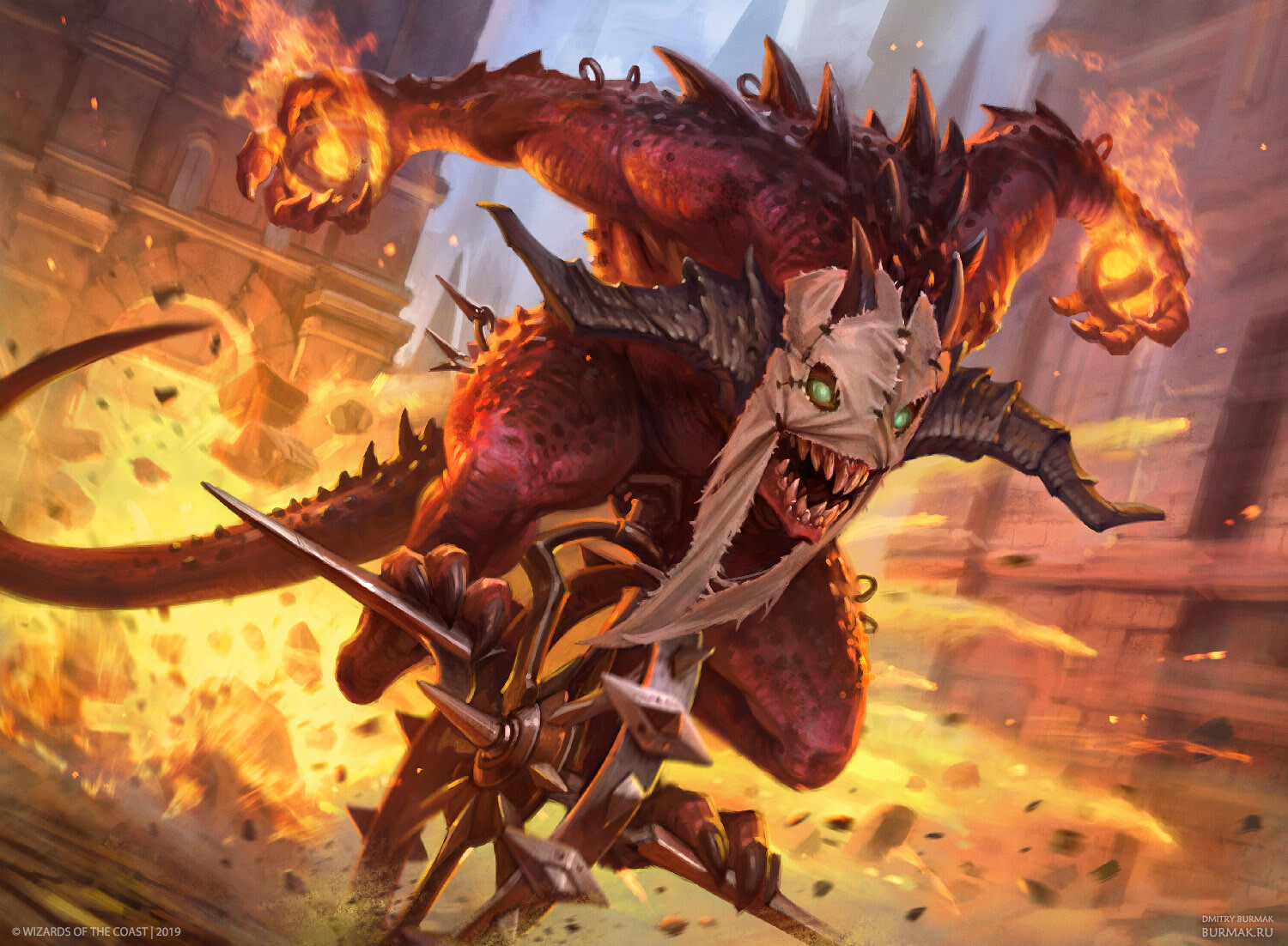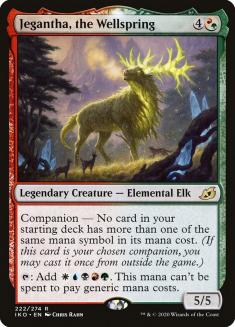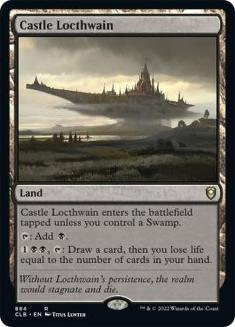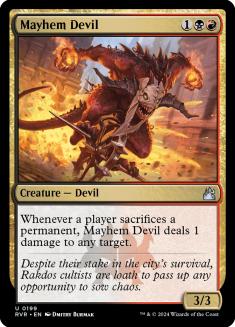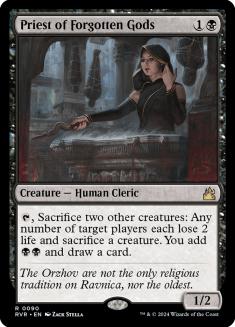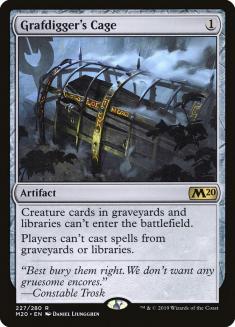It’s rare to have a metagame where several variants of a single strategy coexist for long. Eventually, one of the variants will separate itself from the rest and the metagame will adjust accordingly. But for the last several weeks in Historic, we’ve seen three different Sacrifice decks put up significant results despite all being quite similar.
With so much focus on that format right now, I’m looking deeper at these Sacrifice decks to see exactly how they differ, and which one seems to me to be best-poised to continue or increase its success in the future.
Let’s look at the three popular Sacrifice variants in Historic, along with some notes about how they are commonly built. First is Rakdos:
Creatures (25)
- 2 Scrapheap Scrounger
- 3 Midnight Reaper
- 4 Priest of Forgotten Gods
- 4 Dreadhorde Butcher
- 4 Mayhem Devil
- 4 Cauldron Familiar
- 4 Woe Strider
Planeswalkers (2)
Lands (25)
Spells (8)

This deck should be familiar to those who played a lot of Standard before Zendikar Rising, where it was among the best-performing decks. The idea is to supplement the sacrifice synergies with more aggressive elements, so that you can have a strong early-game to go along with the powerful mid- to late-game that those synergies and the deck’s many recursive threats provide.
Some lists of this version eschew Dreadhorde Butcher for Stitcher’s Supplier, which offers some potential card advantage when you mill a recursive creature, as well as a slightly lower curve to help set up Priest of Forgotten Gods. I prefer the aggressive potential of Butcher, especially in a deck that has so many threatening creatures that your opponents will want to save their removal for.
There are also lists that play Jegantha, the Wellspring as a companion at the expense of playing Chandra, Torch of Defiance and some sideboard cards. I don’t find Jegantha to be worth the cost, since Chandra is a significantly more powerful card and, as a two-color deck, you don’t have as many sideboard options to begin with.
Next we have the Jund Company variant:
Creatures (25)
- 2 Scrapheap Scrounger
- 3 Midnight Reaper
- 4 Priest of Forgotten Gods
- 4 Dreadhorde Butcher
- 4 Mayhem Devil
- 4 Cauldron Familiar
- 4 Woe Strider
Lands (23)
Spells (12)

Similar to the Rakdos list, Jund Company uses Collected Company in the Chandra slot as its curve-topper. For a deck that plays lots of three-mana creatures and wants to assemble specific combinations of them, Collected Company is about as good as it gets. And since Collected Company fits the restriction on Jegantha, the companion slots in more easily.
The question for this deck will be whether or not adding a third color to the manabase is worth these gains in power level.
The last variant is also Jund, but uses the well-known Food engine from Throne of Eldraine:
Creatures (19)
Planeswalkers (3)
Lands (25)
Spells (13)
Sideboard

This deck is easily the least aggressive of the three, but between Trail of Crumbs; Chandra; and Korvold, Fae-Cursed King, it has by far the strongest end-game. We saw this engine compete with the card advantage from Uro, Titan of Nature’s Wrath and Hydroid Krasis in Standard and it can still do so in Historic. The question here is whether you lose too much in matchups where speed is important, like Mono-Red Goblins or the newly emergent Paradox Engine decks.
Evaluating these three decks is tricky because you have to consider the decks both in a vacuum and within the context of the Historic metagame. I’ll start with the general variables and move on to the more specific ones.
Three Colors Are Better Than Two
I generally favor decks with consistent mana and typically that means erring towards fewer colors. But in recent years, aggressive decks with two colors of mana have not fared well. This was the weakest aspect of Rakdos Sacrifice when I played it in Standard last summer and little has changed now. The list above is playing Temple of Malice and Canyon Slough, which, while not universal, demonstrate just how quickly the land options drop off when you’re still in two colors.
By adding green, you do add some inconsistency from needing to find three colors, but you open yourself up to playing a ton of other quality two-color lands, like fastlands, Pathways, and additional shocklands. With higher-quality lands and utilizing cards that aren’t as color-intensive like the swap of Chandra for Collected Company, your mana actually improves by adding a third color. In the case of the Food variant, you also get access to Gilded Goose as a mana fixer.
The real cost for playing a third color comes from taking extra damage from those shocklands as well as playing fewer utility lands. The shocklands would be more worrisome if Mono-Red Aggro were popular, but it isn’t. The creature decks in Historic, like Azorius Auras and Mono-Red Goblins, play more to the battlefield, which makes Mayhem Devil and Priest of Forgotten Gods excellent against them, and I’d rather have Trail of Crumbs or Collected Company to find them quickly.
As for utility lands, the difference is mainly in Rakdos getting to play Castle Locthwain. It’s a powerful card, no doubt, but it’s not worth missing out on powerful payoffs and a significantly better sideboard.
I don’t know why Wizards of the Coast (WotC) won’t let us have two-color aggro decks with reasonable mana, but it’s been like this for years. I’ll revisit Rakdos when it gets access to a Pathway as another good two-color land, but ultimately it’s the fact that the Jund manabase is perfectly fine that makes the third color worthwhile, and there are diminishing returns on making your mana better once it functions at a competitive level.
Aggression Is Important
The hallmark of Magic for the last few years has been versatility. While much of the press has been about the power of threats, we’ve also seen plenty of powerful answers printed recently. Cards like Abrade, Mystical Dispute, and the cycle of color hosers from Core Set 2020 have made shutting down linear strategies easier than ever. Historic also has Thoughtseize, among the best disruption cards ever printed.
Not all of these cards will be great against Sacrifice decks, but the wealth of options available to your opponents means that they likely have the tools to stop your primary plan. Either you’ll be limited to playing Sacrifice strategies at times when the metagame is unprepared, or you have to develop a secondary plan.
Since all of the Sacrifice variants play Cauldron Familiar, Mayhem Devil, Woe Strider, and Claim the Firstborn, the natural secondary plan is laying some beatdowns. That’s why I like Dreadhorde Butcher in these decks, since it’s great at applying early pressure and forcing your opponent into a corner.
When you push an early advantage like this, you can force your opponent to use their disruption suboptimally, either killing a Butcher before it gets out of control or an early Woe Strider that you can escape back later. All the while, you’re holding back the threats that are more important for assembling your sacrifice synergies, like Mayhem Devil and Priest of Forgotten Gods.
As I noted earlier, the aggro plan also gives you a better chance in matchups where your opponent can go over the top of your synergies, like Paradox Engine or Neostorm. Korvold and Trail of Crumbs are liabilities in matchups like that, since your opponent can easily ignore them and focus on assembling their combo while playing around the little disruption from your deck that matters. And while I list some specific examples from current Historic, it’s important to note that decks that go over the top show up in nearly every format, and this dynamic will always be at play unless you’re playing a small tournament with a metagame skewed heavily towards fair decks.
Next we’ll move on to the variables that are more specific to the current Historic metagame.
The Grafdigger’s Cage Problem
When it comes to hate cards in Historic, Yasharn, Implacable Earth is the most devastating for Sacrifice strategies, but it’s not in many decks and comes on a body, making answering it straightforward. However, Grafdigger’s Cage is nearly as impactful but sees play in a variety of different decks and is much more difficult to answer, being an artifact. Thus, it’s important to consider how exposed each Sacrifice variant is to the powerful sideboard card and how well set up they are to answer one.
On the first metric, the Collected Company variant grades worst. All of the decks have Woe Strider and Cauldron Familiar that are shut down by Cage, but the other two decks don’t have much else. Trail of Crumbs is limited by its partner in crime, Cauldron Familiar, being nerfed, and the Rakdos list plays Scrapheap Scrounger, but that’ll still attack and block on its first go-around. Rakdos lists that play Stitcher’s Supplier will get hit worse by Cage, since it won’t accrue value, but that’s just another reason to play Dreadhorde Butcher.
Jund Company adds another key piece to the list of cards that are shut down by Cage. Collected Company is a great card in the deck, but exposing yourself to such a common hate card is quite the cost. Thankfully, that variant mitigates the risk by also playing more answers. In addition to the ubiquitous Abrade, we see three copies of Reclamation Sage, which is particularly good against Azorius Control, a deck that plays Cage and where Abrade would be quite weak.
I’d look for room for Reclamation Sage in Jund Food as well, though it’s clear that that deck needs more anti-aggro elements in its sideboard since its maindeck doesn’t play defense as well as the creature-heavy lists. Since Jund has that option, I’d grade it ahead of Rakdos slightly on this metric, though the option to beatdown with Dreadhorde Butcher in the face of hate is appealing.
Matching Up to Sultai Midrange
The other metagame consideration is the format’s current bogeyman: Sultai Midrange. It put six players into the Top 8 of the Zendikar Rising Championship as well as last weekend’s Kaldheim Championship Qualifier. Until further notice, this is the deck to beat.
In matching up against Sultai, I’m once again leaning away from the two-color build. You need some raw power since it’s rare to run them over with aggression. But I still like having aggressive elements, because you need to close the game at some point. Uro, Hydroid Krasis, and friends are too powerful going long, so while you can hang with them into the mid-game, it’s important to recognize that they’re the ones with inevitability.
I could be persuaded away from aggression if it meant having threats that line up better against their answers, but I don’t think Jund Food meets that criterion. All of its heavy hitters – Trail of Crumbs, Chandra, and Korvold – are answered by Aether Gust, and in the case of the latter two, answered at a significant mana advantage for the opponent. At least Collected Company, by virtue of being an instant, can make Aether Gust awkward.
Jund Company strikes the best balance between power, aggression, and making Sultai’s answers awkward. And when it comes to playing fair Magic against a deck as powerful and flexible as Sultai Midrange, that’s the best you can do. There’s no hate card that shuts them down and no miracle sideboard transformation that will put you far ahead in the matchup. You just have to make sure your strategy is powerful enough to hang with them and bide your time for a moment of weakness where you can turn the corner and close out the game.
So Which List Is Best?
Based on the above criteria, I would favor Jund Company. It has the best balance of power and aggression, and with the emerging dominance of Sultai Midrange, there aren’t as many Grafdigger’s Cages around as there used to be. In a metagame with a lot of Cages, I could see switching over to Jund Food, but I would stay away from the Rakdos builds entirely. There just isn’t enough of a payoff for staying two colors, while you sacrifice significantly in terms of raw power and sideboard flexibility.
These next few weeks are going to be a big test for Historic and whether it has the tools to contain Uro and friends, or whether we’ll add another format to the list where it forced a ban. Rakdos Sacrifice was my tool of choice to answer Sultai in Standard last summer, and I was happy with that matchup. With the addition of Collected Company, I think Jund can stand up to the menace once again.

